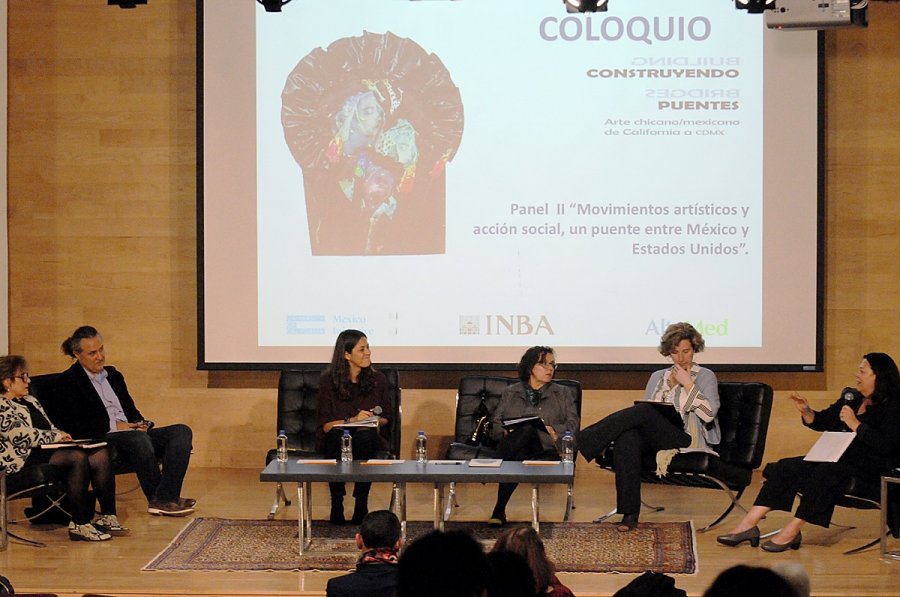Noticias
Rufino Tamayo Museum
“There are few Latin American and Chicano art studies”: Charlene Villaseñor Black
November 07, 2018Dr. Charlene Villaseñor Black, professor of Art History and Chicano Studies at the University of California, Los Angeles, said that research on Chicano and Latin American art requires greater motivation to increase its analysis in U.S. institutions of higher education as well as a greater inclusion in art publications and university boards.
As part of the talk Building Bridges: Chicano/Mexican art from California to Mexico City she recalled that the first major Latino art exhibition was held 28 years ago, in 1990. She said that recently more than 80 exhibitions were presented, reflecting a historical moment for Latin American or Chicano art that will mark a new trend in museum practice in the United States.
She pointed out that there are still few publications dealing with or editing Latin and Chicano art, as well as research on the subject. This is demonstrated by the fact that there are limited colloquiums or seminars that address this issue in the universities of the United States, but she remarked that she will look for more boards on Latin and Chicano art.
The most important art history magazine, The Art Bulletin, founded in 1913, has never published anything on Chicano-Latin art, except for a small number of articles on Latin American art, including pre-Columbian, modern colonial, which have increased recently.
This is not the case for Art Journal, another of the most influential art magazines in the United States, founded in 1931, which has several important articles on the subject. But Aztlán is the leading magazine in Chicano and Latino art studies.
Dr. Mariángela Rodríguez Nicholls who also participated in the lecture, Building bridges: Chicano/Mexican art from California to Mexico City, said that we are inserted in a problem in which we are all ruled by a precarious structural unemployment, of flexible accumulation, where the productive process has gotten worse.
The research professor at the Center for Research and Higher Studies in Social Anthropology (CIESAS, for its acronym in Spanish), added that the Chicano movement is the first postmodern movement, "because it is delocalized, as a characteristic”.
In other words, "cultures are delocalized. They are not side by side, but they migrate with their contingents of population that go from one continent to another, from the peripheral countries to the metropolitan countries”.
Populations "migrate with their fund of knowledge. When they un-territorialize, they re-territorialize and create, through historical memory, their historical memory with the contemporary movements with which they have to allign themselves, they create a third way of approaching art".
In this sense, the Chicano movement has put into action "the agency", the capacity of the human being to respond in a resilient manner to a very adverse situation such as that experienced in the United States with racism, discrimination, and lack of opportunities.
This struggle has opened up artistic spaces. "Creativity is what allows movements like the Chicano", in the United States, where the pre-Hispanic culture is perceived much more than here, as Carlos Monsivais said.
"They looked at the past, but creatively. They broke down structures and incorporated things from the local culture into Chicano art that recovers identity, into a pride of race”.
Dr. Martínez-Zalce said in roundtable 2, Artistic Movements and Social Action: A Bridge Between Mexico and the United States, that the readings offered by documentaries and films, El Norte, among them, explain today's migratory movements as the caravan of Hondurans on national land on their way to the United States.
"This film serves us today, my students, to see what the differences are in the crossing stories about the Mexican Republic, to reach the United States”.
"Watching this movie again today, confronted with the images that we are seeing every day in the news of that caravan that looks immense and that in reality is very small because only 5,000 humans, in a country of 120 million people, make us see how the figure of the emigrant coming from Central America to the United States crossing through Mexico has changed”.
It shows how Mexico's conditions have changed and how, nevertheless, the issue of crossing, in all the narratives of all the movies: Sin nombre, La jaula de Oro and La Bestia, among others, remains very similar.
"They teach the deep meaning of what it means to be Mexican, Central American, in a world of blondes”.
Dr. Guillermo Alonso Meneses, anthropologist and researcher, head of the department of Cultural Studies at the Frontera Norte School, said that behind every artist there is an ethical and political dimension that has diverse impacts on the community, not only with his work, but with his lifestyle.
The talk Building Bridges: Chicano/Mexican art from California to Mexico City was moderated by Veronique Rorive, anthropologist, deputy director of the UC-Mexico initiative and Patricia Fernandez, internationalist and cultural manager, and director of International Affairs at the National Institute of Fine Arts.
Mexico
